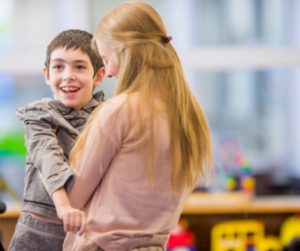I saw this phrase recently referring to non-verbal, minimally verbal, and disabled children, and I loved it. Assume competence. What does that mean? It means that you assume the person you are talking to understands you. It means you assume they can do things until they let you know they can’t. It means that you treat them like a person.
 I see a lot of online posts of parents talking about how their non-verbal or minimally verbal child has violent outbursts or tantrums. Every time I see one of these, I want to ask SO many questions. In my experience, people have tantrums and act out for a reason. If you are struggling with your child, here is a list of reasons they may be upset that you should consider.
I see a lot of online posts of parents talking about how their non-verbal or minimally verbal child has violent outbursts or tantrums. Every time I see one of these, I want to ask SO many questions. In my experience, people have tantrums and act out for a reason. If you are struggling with your child, here is a list of reasons they may be upset that you should consider.
Basic Needs
Are the child’s basic needs met? Are they hungry? Tired? Over stimulated? There are a whole lot of behavior issues that are a result of a child needing a snack and some quiet time. Children can hit a growth spurt at any time, and that growth spurt can make them more hungry or tired than usual. If you are introducing a picture form of communication, or AAC device, adding ways your child can let you know if they are thirsty, hungry, or sleepy is essential. Add those pictures early, and make sure your child knows that when they indicate they feel one of those you will respond. Even if you can’t meet their need at this moment, tell them you will help them as soon as possible.
Communication
 Sometimes, people assume that if a person cannot talk, they don’t understand what you are saying to them. This is one of the most idiotic positions you can take. Don’t do that. Research shows that people who struggle to communicate usually understand the majority of what is said to them. Just like anyone else, their life experience will determine how extensive their vocabulary is, but you should assume they understand the same vocabulary as any other child their age.
Sometimes, people assume that if a person cannot talk, they don’t understand what you are saying to them. This is one of the most idiotic positions you can take. Don’t do that. Research shows that people who struggle to communicate usually understand the majority of what is said to them. Just like anyone else, their life experience will determine how extensive their vocabulary is, but you should assume they understand the same vocabulary as any other child their age.
When you talk about a child in front of them, they understand you. Be careful what you say and do your best to engage the child. Whatever you are saying about your child, would you be upset if someone said that about you? If so, don’t say it. It is also your job to correct teachers and other adults who are in your child’s life.
Most non-verbal children DO communicate. They may use facial expressions, movements, gestures, or words if they do not have a device or sign language to use. Pay attention to what your child is actually doing, and you should be able to decode what they are trying to let you know.
Yes, I said that many non-verbal people use words, this is technically called minimally verbal, but if they don’t use a lot of words, they may still be called nonverbal. They often have trouble using as many words as a typical vocabulary contains, but that doesn’t mean they do not have the ability to use words. Being nonverbal often means that the part of your brain that creates words has a hard time sending all the necessary signals to your mouth. Saying words is often possible (though not always) for this population, but it is a lot harder for them. That means that when they do manage to say words, you need to pay attention. They worked hard to get that word out for you. Respect it, and respond to them as though they said a full sentence. That doesn’t mean you have to always say yes, but you need to acknowledge what is said to you.
 Here is an example:
Here is an example:
Child: Cookie
Parent: Oh, you want a cookie? I love cookies. I can give you one cookie now, but we have to wait until after dinner to have more. Okay?
Child: Cookie!
Parent: Here is your cookie. (Hands over a cookie.)
Child: *grunts*
Parent: You are welcome. (This assumes the child’s grunt meant “thank you” because their home uses that word a lot.)
See how that exchange is treating the minimally verbal child like a person? The parent is talking to them in whole sentences and acting like the child used a whole sentence. This helps the child build their own vocabulary, even if they cannot express it. The child also feels better about this exchange because they see others are talked to in this manner. They recognize they are being treated like everyone else.
Activities
 If your child is prone to outbursts while doing activities, there are two causes to consider. Is the child being allowed to do all they can do? Is this activity way too hard?
If your child is prone to outbursts while doing activities, there are two causes to consider. Is the child being allowed to do all they can do? Is this activity way too hard?
Too often, parents or teachers give a nonverbal and/or disabled child a task like coloring or painting and then don’t let them do it. They take it over, wanting the product to be like everyone else’s. This is frustrating to the child, and horrible for their self-expression. It is important to remember that great artists don’t color inside the lines. Treat your child like a great artist and let them do things for themselves, even if it doesn’t look “right.”
If the activity is just too hard, a child can also be frustrated. It is important to give them a chance to succeed. Let them try. Let them do their best. Assume the child CAN do things other children do, and then figure out what they need to be successful. Do they need an adaptive pencil holder? Do they need larger paper? Do some research and talk to an OT to figure out what adaptive equipment will help them be successful.
Remember
What most people want is to be treated with the same respect that everyone else gets. They want to be able to do what other people do and be talked to with the same respect.





0 Comments